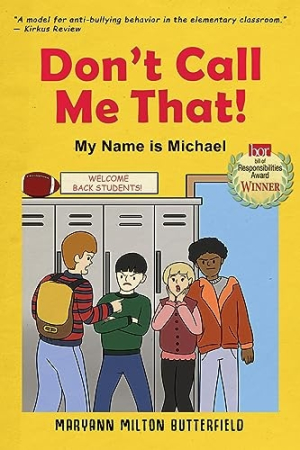
Don’t Call Me That!
My Name Is Michael
Don’t Call Me That! is an inspirational novel in which a bullied boy learns to stand up for himself—and others.
In MaryAnn Milton Butterfield’s novel Don’t Call Me That!, a Korean American student endures harassment rather than asking for help.
Moving to a new school for his sixth grade year, Michael is scared on his first day. His best friend Jason is with him, but Michael will still be the only Asian kid in school. To make matters worse, his parents have given him new responsibilities, like waking up in the morning on his own and taking the school bus.
Then Chuck, a bigger student who lives nearby, starts calling Michael “Chung King” and laughing at him. When Michael tells Chuck to stop, the teasing gets worse. Without help from his mother, Michael feels ashamed and silenced. He hides from his bully and avoids the supportive adults around him.
The story models ideal reactions to bullying. Indeed, Jason steps in when Chuck’s bullying becomes intolerable, convincing Michael to tell an adult. In time, the school’s parents, teachers, and students come together to understand and resolve the conflict. This is dependent on a delicate balance of circumstances, though, including a healthy family and virtuous boys. The causes and effects of the bullying remain ambiguous.
In the final quarter of the book, the tables turn on Michael. He is culpable for wronging the bully who has been tormenting him for weeks. This sudden realization is handled with care, conveying the book’s ultimate moral well: that everyone is responsible for treating others with dignity and respect.
Moving at a brisk pace, the narration is quite direct, favoring clarity over embellishments. Still, it includes warm scenes not related to the bullying, as of Michael and Jason building a fort with their fathers. Elsewhere, Michael loses his concentration at school because of his mounting anxiety. Nonetheless, each day begins and ends with his regular routine: he goes to school in the morning and comes home in the afternoon.
The book’s cramped font makes for dense reading. More complementary are its regular, charming illustrations, whose crayon-drawing style is lively. Its supplemental reading questions and code of conduct guide drive its message home, while its information on how to build a fort is a fun addition.
Don’t Call Me That! is an inspirational children’s novel in which a bullied boy learns to stand up for himself—and others.
Reviewed by
Willem Marx
Disclosure: This article is not an endorsement, but a review. The publisher of this book provided free copies of the book and paid a small fee to have their book reviewed by a professional reviewer. Foreword Reviews and Clarion Reviews make no guarantee that the publisher will receive a positive review. Foreword Magazine, Inc. is disclosing this in accordance with the Federal Trade Commission’s 16 CFR, Part 255.
